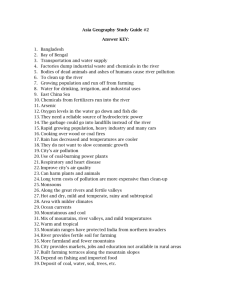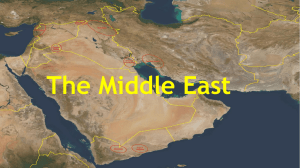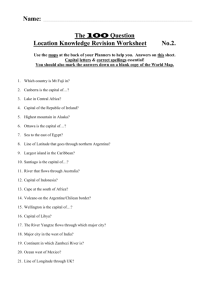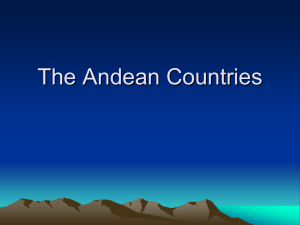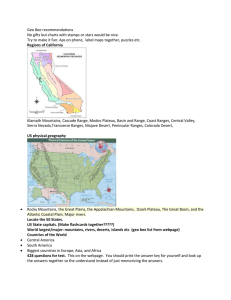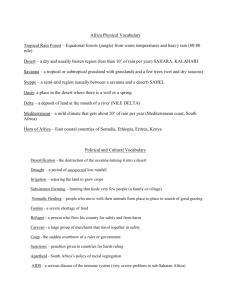“Cold Land” – Potatoes, Apples, Wheat
advertisement
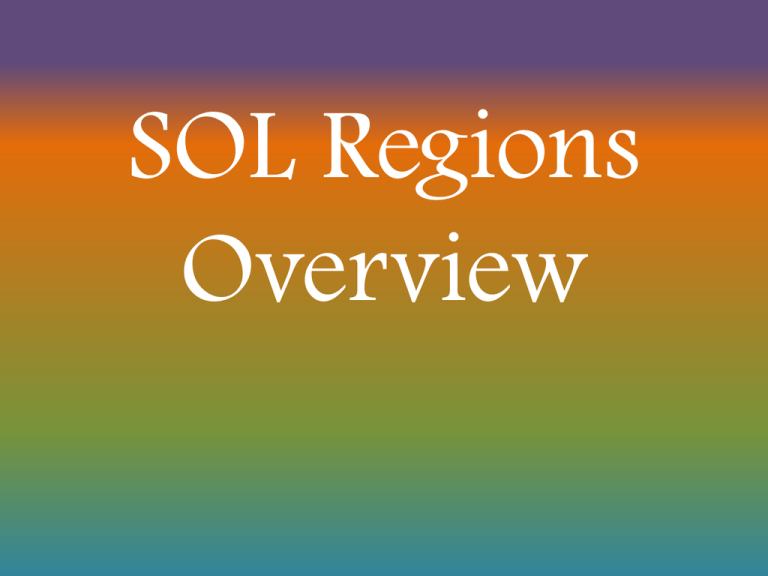
SOL Regions Overview United States/Canada Physical features Canadian Shield: flat, rocky area around the Hudson Bay Rocky Mountains: tallest mountain range (Western U.S./Canada) Continental Divide: Point in the Rockies where the rivers change direction. Piedmont: Foot of the Mountain (Appalachian) Mississippi River ends in the Gulf of Mexico The Rio Grande River makes up part of the U.S/Mexico border St. Lawrence River makes up part of U.S./Canadian border Cultural Characteristics •Colonized by Europeans •Very Multicultural Society •Developed Countries (high literacy rates, high standard of living, highly urbanized) •Canada struggles to maintain a national identity – French and English both spoken •Unfortified border between U.S./Canada •Democratic governments •Both members of NAFTA (North American Free Trade Agreement) w/ Mexico Economic Characteristics •Major exporters of technology, consumer goods, foodstuffs, information systems •Highly developed infrastructures •Diversified economies (primary, secondary, and tertiary levels) – majority employed in tertiary activities •Mineral, energy, forest resources •New York Stock Exchange – center of world financial markets •Widening gap between rich and poor •U.S. culture has spread throughout the globe. Latin America Physical Features •Seasons reversed south of the equator •Pampas: grasslands in Argentine •Llanos: grasslands in Colombia and Venezuela •Tropical climates predominant •Volcanoes and Earthquakes common natural disasters (along Ring of Fire) Tierra Fria(11,500) “Cold Land” – Potatoes, Apples, Wheat •Vertical Zonation Tierra Templada (6,000-6,500ft) “Temperate Land” – corn, coffee beans, Wheat, Citrus Fruit Tierra Caliente (2,500-3,000 ft) “Hot Land” – rice, sugar cane, rubber, bananas, cocoa Cultural Characteristics •Indian Civilizations (Inca, Aztec, Maya) •African traditions because of slave trade •European influence because of colonization •Roman Catholic Religion dominant •Rigid Social Structure during colonization (Colonists at top, mestizos in middle, natives at the bottom •Mestizo: person of mixed European and native descent. •Settlements located near the coast in S. America •Rapid population grown, move to cities and squatter settlements •Spanish spoken in most of Latin America – Portuguese spoken in Brazil Economic Characteristics •Subsistence Agriculture (self-sufficient agriculture) •Plantation Agriculture (haciendas) – large farms that grow cash crops •Slash and Burn Agriculture/Deforestation – cutting down rainforest for farmland. •Ecuador, Venezuala, and Mexico have large oil resources •Mexico City suffering from heavy pollution. Very smoggy! •Big gap between rich and poor •Mexico a member of NAFTA •Diverse mineral resources: copper in Chile, Iron ore in Venezuela and Brazil Europe Physical Features •Europe is a huge peninsula made up of peninsulas (Iberian, Balkan, Scandinavian, Jutland, Italian) •Ural Mountains separate the European continent from the Asian continent (Eurasia) •The Urals go through Russia •North Atlantic Drift (warm ocean current) provides Europe with a more moderate climate than Canada at the same latitude Cultural Characteristics •Europe has MANY different ethnic groups, languages, and cultures •High population density – many people live in cities •Historic conflict among groups (revolutions, wars) •Birthplace of Western Democracy – Athens, Greece and Rome, Italy •Birthplace of the Industrial Revolution – London, England •European culture has spread throughout the world •History of Imperialism (exerting control over other countries) •Many countries are members of NATO (North Atlantic Treaty Organization) will the United States and Canada. NATO is a military/political alliance made after World War II Economic Characteristics •Mountainous regions (Alps) good for tourism, recreation, and mining •Black Forest (Germany), Venice, Italy and rivers (Rhine, Seine, and Danube) are all threatened by pollution •Ruhr and Po Valleys are industrial centers because of mineral resources •Oil reserves found in the North Sea •Chernozem (black earth – very fertile soil) allows for good harvests •The Chunnel (underwater tunnel) connects Britain to France •Many countries members of the EU (European Union) – an economic union. •Well developed infrastructure and educated workforce Economic Characteristics ctnd. •Governments very involved in welfare systems and healthcare •Countries interdependent on one another – trade very important •Reclaimed land from the sea (POLDERS) in Netherlands •Most European countries are considered developed (Eastern Europe struggles more though because of history under the Soviet Union) Russia and Central Asia Physical Features •Russia is the world’s largest country – located on two continents (Europe and Asia) •Spans 11 time zones •Large areas of tundra, permafrost, taiga, and steppe •Chernozem soil also found here along with the Fertile Triangle which is good for growing wheat •Ural Mountains – divide Europe from Asia (Siberia is east of the Ural Mountains) •Major oil, natural gas, and mineral resources but they are difficult to get to. Cultural Characteristics •Diverse ethnic groups and customs (From Turkic and Mongol heritage) •Russian Ballet famous •Faberge eggs (decorative eggs originally made for czars) •Russian Orthodox (Form of Christianity) the main religion. Islam is also prominent in Central Asia •Matrioshka dolls and Oriental rugs also a part of the culture. Economic Characteristics •Still going through the transition from a communist to a free market economy (this has been difficult!) •Trans-Siberian Railroad – the largest in the world. Many rivers and canals for trade and transportation as well. •Canals and shipping lanes often freeze in the winter making trade difficult •Widespread pollution (partly because Soviet government did not regulate) •Aral Sea is shrinking because water is being used to irrigate cotton fields •Natural resources not fully developed or taken advantage of because of the vastness of land and often cold weather. N. Africa/SW Asia (Middle East) Physical Features •Crossroads of Europe, Africa, and Asia (important for trade) •Desert and Semiarid climates for the most part •Sahara Desert – largest desert in the world •Nile River – longest river in the world •Sahel – area south of Sahara that is becoming like desert •Alluvial soils – good for agriculture •Wadis – dried up stream beds (fill up when it rains) •Rivers seasonally flood during rainy season (controlled by dams) •Oasis: fertile, green spots in the desert Cultural Characteristics •Rapid Urbanization – big city growth •City life is modern but rural areas are VERY traditional •Large population under age of 15 (low life expectancy, high birth rate) •Population unevenly distributed. Few live in the desert – most live near water (along coast line or near rivers) •Birthplace of 3 monotheistic religions: Christianity, Islam, and Judaism) •Art reflects religious diversity (Stained glass, mosaics, prayer rugs, etc.) •Conflict between Muslims and Jews over Palestine (former name of Israel) •Jerusalem also important to Muslims, Jews, and Christians •Mosques located throughout because of Islam Economic Characteristics •Primary economic activities (agriculture, oil drilling, herding animals) •Major producer of oil – dependent on it •Water most precious resource because it is scarce •Big gap between rich and poor – most very poverty stricken •Aswan High Dam built on Nile (controls flooding but as caused more disease, less soil fertility, and forced people to relocate) •Many members of OPEC (Org. of Petroleum Exporting Countries) •Suez Canal connects Mediterranean to Red Sea – important for shipping •Many regional conflicts •Guest workers come for oil benefits Sub Saharan Africa Physical Features •Composed of huge plateaus and escarpments (steep side of plateau) •River transportation difficult because of many waterfalls and rapids •Equator runs through the area (climate regions mirror each other along equator) •Smooth coastline with few natural harbors •Slash and Burn farming an issue because rainforest soil not very fertile •Many landlocked countries (which hurts economy – harder to trade) •Nature preserves and wildlife parks (Savannas) •Mt. Kilimanjaro the highest peak Cultural Characteristics •Many ethnic groups – conflicts caused because of borders created by European powers during Imperialism •Uneven population distribution •Few cities over 1 million people – many live in rural villages •History passed down through Oral Tradition •Many country names taken from former empires (Mali, Ghana, Zimbabwe) •History of Apartheid (Separation of blacks and whites) in S. Africa •Diversity of language, culture, and ethnicity seen in art (African masks, music, paintings, dance, sculptures) Economic Characteristics •Many people work in agriculture (subsistence agriculture, slash and burn, plantation farming, nomadic herding) •Infrastructures are very poorly developed and governments often corrupt •A “Rich” continent because it has a lot of mineral wealth (most people not wealthy though) •Population is growing but productivity lags behinds (partly because of diseases like AIDS) •Most countries are developing (low life expectancy, low income, high death rate, high birth rate) South, Southeast, and East Asia Physical Features •Mountains influence settlement patterns (less dense in mountains) •Terraced farming •Climate ranges from Tropical wet to Humid Continental •Volcanoes and earthquakes typical along the Ring of Fire •Typhoons in Pacific Ocean, Cyclones in Indian Ocean •Monsoons common in Asia – summer monsoons bring rains and floods •A lot of arable land – good for farming •Loess – fertile, yellow soil in China Cultural Characteristics •Some areas very densely populated, others very sparse •Urban areas modern and rural areas very traditional •Religious Diversity: Hinduism, Buddhism, Christianity, Islam, Taoism, Confucianism (philosophy), Shinto •Caste system in India (Hindu) –Strict social structure, still somewhat followed today. •Great respect for ancestors •Religious/Political Conflict: Hindus and Muslims fighting over Kashmir in Pakistan and India Economic Characteristics •Varied economies: Subsistence agriculture for some all the way up to very high tech industry and innovation for others •Asia participated in global markets •Taiwan, South Korea, and Singapore newly industrialized •Japan the economic leader •Agricultural advancements because of use of fertilizers, pesticides, etc. have led to greater production – called the “Green Revolution” •Rice and tropical crops major cash crops •Fishing also important to the region •Pollution and deforestation also an issue Australia Oceania and Antarctica Physical Features •Vegetation ranges from Tropical Wet to Desert (1/3 of Australia is desert though) •The Great Dividing Range has the largest mountains in Australia (none taller than 5000 feet) – Australia is very flat •The Great Barrier Reef is the largest coral reef in the world •Australia’s isolation has caused unique animal life (kangaroos, wombats, etc.) •Antarctica is the coldest, driest, windiest continent •Pacific islands made from volcanoes (high islands) or coral reefs (low islands) Cultural Characteristics •Pacific Islands are sparsely population •Most of Australia’s population lives near the coast (hardly any in the desert and outback) •Traditional cultures very strong in the Pacific Islands •Lifestyles range from subsistence farming to modern city living •European influences because of colonization •Native cultures also play a major role (Aborigine = Australian Native and Maori – New Zealand Native) •Antarctica has no permanent residences. It has been set aside as a scientific reserve (Antarctic Treaty System) Economic Characteristics •Air and Water travel important for trade because of island nations •Dry areas of Australia good for cattle and sheep farming. •Environmental balance upset because non-native plants and animals have been introduced to the area •Ranching and Mining are the primary economic activities •
